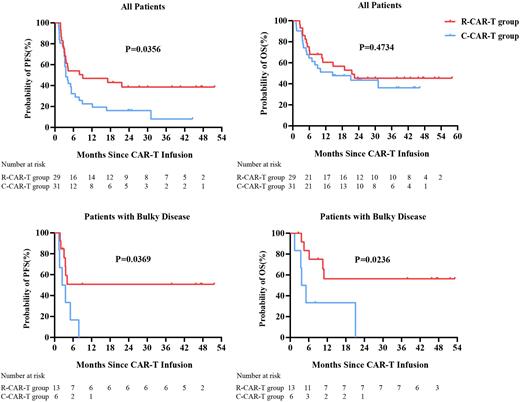Abstract
Purpose: Dual targeting of CD19/CD22 chimeric antigen receptor (CAR) T-cell therapy has emerged as a promising strategy for relapsed/refractory aggressive B-cell lymphoma (r/r ABL). To date, cytotoxic chemotherapy is commonly applied as a bridging regimen prior to CART infusion to temporarily mitigate heavy tumor burdens. The optimal bridging treatment is still unknown, although some case-series or small-scale studies have indicated that the radiotherapy priming CAR-T strategy shows some potential advantages. We aimed to further analyze the safety and efficacy of a radiation bridging regimen with or without chemotherapy compared with chemotherapy alone prior to CAR T-cell treatment for r/r ABL.
Methods and Materials: Data from sixty patients receiving anti-CD22 and anti-CD19 therapies, two single specific, third-generation CAR T-cell "cocktail” therapies with bridging regimens as chemotherapy alone (C-CAR-T group, n=31), and radiotherapy with or without chemotherapy (R-CAR-T group, n=29) between February 2017 and October 2020 were retrospectively analyzed.
Results: No significant toxicities were identified in the R-CAR-T group, and no patients in either group experienced CAR-T-related deaths. However, the group with the bridging radiation regimen showed a lower incidence of cytokine release syndrome (CRS) of grade ≥ 3 relative to the C-CAR-T group (0%, 95% confidence interval [CI], 0% to 14.6% vs. 19.4%, 95% CI, 8.1% to 38.1%; P=0.036). The incidence of neurological toxicity was 9.9% (95% CI, 2.5% to 26.9%) and 6.9% (95% CI, 1.2% to 24.2%) in the C-CAR-T group and R-CAR-T group, respectively (P=0.697), and no patient experienced grade 3-5 neurological toxicity in either group. The patients in the R-CAR-T group achieved a higher overall response rate (ORR) at the day 30 assessment (82.8%, 95% CI, 63.5% to 93.5% vs. 45.2%, 95% CI, 27.8% to 63.7%; P=0.0025). In univariate subgroup analysis, age older than 60 years was analyzed as a negative factor of the best ORR in the R-CAR-T group (57.1%, 95% CI, 20.2% to 88.2% vs. 95.5%, 95% CI, 78.2% to 99.2%; P=0.034). Further analyzing the outcomes, the patients in the R-CAR-T group presented a better 1-year progression-free survival (PFS) rate than those in the C-CAR-T group (46.9%, 95% CI, 27.9% to 63.7% vs. 22.6%, 95% CI, 10.0% to 38.6%; P=0.0356; Figure 1). Intriguingly, the bridging radiation regimen extremely improved the 6-month PFS (50.8%, 95% CI, 21.4% to 74.2% vs. 16. 7%, 95% CI, 0.8%-51.7%; P=0.0369) and 1-year overall survival (OS) (56.3%, 95% CI, 24.4% to 79.1% vs. 33.3%, 95% CI, 4.6% to 67.6%; P=0.0236) rates in patients with bulky disease (Figure 1). The study also found that conducting radiotherapy as a bridging regimen was an independent factor that predicted better PFS (HR [hazard ratio]: 0.534, 95% CI: 0.289-0.987; P=0.045).
Conclusions: Our results provide and strengthen novel insights that the use of radiotherapy as a bridging strategy was demonstrated to reduce the incidence of severe CRS and improve the PFS of patients. In subgroup analysis, it was confirmed that radiotherapy can improve PFS and OS in patients with bulky disease. These findings open new avenues to improve the efficacy and safety of CAR T-cell therapies, especially for patients with large tumor burden resistance to prior chemotherapy and radiotherapy. Future designs to prospectively optimize the use of bridging radiotherapy and elucidate the mechanism involved are warranted.
Disclosures
No relevant conflicts of interest to declare.
Author notes
Asterisk with author names denotes non-ASH members.


